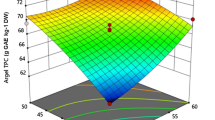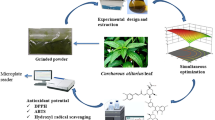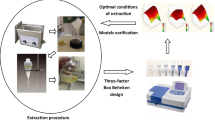Abstract
The aim of this research is to optimize the extraction of phenolic compounds from the aerial parts of Haloxylon scoparium by employing ultrasound-assisted extraction (UAE) and subsequently compare the results with those obtained through a conventional extraction method (maceration). Additionally, a novel physics-based metaheuristic optimization algorithm known as the Henry gas solubility optimizer (HGSO) is introduced to fine-tune the extraction conditions for achieving maximum phenolic compound yield. The response surface methodology (RSM) is employed to develop a mathematical model for the total phenolic compound content (TPC). Based on the optimal results obtained through HGSO for UAE method, a maximum phenolic compound yield of 191.88 mg GAE/g DM was achieved, with a solid–liquid ratio of 5 g/mL, a 60% methanol concentration, and a 40-min sonication period. While the yield obtained through maceration was 105.87 mg GAE/g DM. The TPC extracted from both UAE and maceration was quantified using LC–ESI–MS/MS analysis. Moreover, our comparative analysis unveiled that the UAE surpassed the conventional extraction method in several key aspects. Specifically, it exhibited superior performance in terms of extraction yield (outperforming the traditional method by 44%), total flavonoid content, and antioxidant activities. These comparisons were based on the results of four distinct assays: DPPH, ABTS, reducing power, and phenanthroline. Our study provides valuable insights into the correlation between phenolic compounds and antioxidant capacities. UAE not only achieved higher phenolic compound yields but also demonstrated enhanced antioxidant activity within a short extraction time. This eco-friendly method of extraction holds great potential as a source of antioxidants and finds applications in the pharmaceutical and food industries.





Similar content being viewed by others
Data availability
There is no supplementary information. All the data are in the manuscript.
References
Kharchoufa L, Bouhrim M, Bencheikh N, El Assri S, Amirou A, Yamani A, Choukri M, Mekhfi H, Elachouri M (2020) Acute and subacute toxicity studies of the aqueous extract from Haloxylon scoparium pomel (Hammada scoparia (Pomel)) by oral administration in rodents. Biomed Res Int. https://doi.org/10.1155/2020/4020647
Lachkar N, Lamchouri F, Bouabid K, Senhaji S, Boulfia M, Akabli T, Zalaghi A, Toufik H (2023) In vitro study of the antimitotic power and in vivo acute toxicity of aqueous and organic extracts of the aerial part of Haloxylon scoparium Pomel. and evaluation of the correlation between the chemical profile and their biological activities. Plant Sci Today 10(1):242–251
Alotaibi BS, Ijaz M, Buabeid M, Kharaba ZJ, Yaseen HS, Murtaz G (2021) Therapeutic effects and safe uses of plant-derived polyphenolic compounds in cardiovascular diseases: a review. Drug Des Dev 4713–4732
Elshafie HS, Camele I, Mohamed AA (2023) A Comprehensive review on the biological, agricultural and pharmaceutical properties of secondary metabolites based-plant origin. Int J Mol Sci 24(4):3266
Benkherara S, Bordjiba O, Harrat S, Djahra AB (2021) Antidiabetic potential and chemical constituents of Haloxylon scoparium aerial part, an endemic plant from Southeastern Algeria. Int J Second Metab 8(4):398–413
Maher T, Kabbashi NA, Mirghani MES, Alam MZ, Daddiouaissa D, Abdulhafiz F, Reduan MFH, Omran JI, Abdul Razab MKA, Mohammed A (2021) Optimization of ultrasound-assisted extraction of bioactive compounds from acacia Seyal gum using response surface methodology and their chemical content identification by Raman, FTIR, and GC-TOFMS. Antioxidants 10(10):1612
Saifullah M, McCullum R, McCluskey A, Vuong Q (2020) Comparison of conventional extraction technique with ultrasound assisted extraction on recovery of phenolic compounds from lemon scented tea tree (Leptospermum petersonii) leaves. Heliyon 6(10):e03666
Gajic IS, Savic I, Boskov I, Žerajić S, Markovic I, Gajic D (2019) Optimization of ultrasound-assisted extraction of phenolic compounds from black locust (Robiniae pseudoacaciae) flowers and comparison with conventional methods. Antioxidants 8(8):248
Dash DR, Pathak SS, Pradhan RC (2021) Improvement in novel ultrasound-assisted extraction technology of high value-added components from fruit and vegetable peels. J Food Process Eng 44(4):e13658
Grassino AN, Ostojić J, Miletić V, Djaković S, Bosiljkov T, Zorić Z, Ježek D, Brnčić SR, Brnčić M (2020) Application of high hydrostatic pressure and ultrasound-assisted extractions as a novel approach for pectin and polyphenols recovery from tomato peel waste. Innov Food Sci Emerg 64:102424
Rathnakumar K, Kalaivendan RGT, Eazhumalai G, Raja Charles AP, Verma P, Rustagi S, Bharti S, Kothakota A, Siddiqui SA, Manuel Lorenzo J, Pandiselvam R (2023) Applications of ultrasonication on food enzyme inactivation- recent review report (2017–2022). Ultrason Sonochem 96:106407
Chemat F, Rombaut N, Sicaire AG, Meullemiestre A, Fabiano-Tixier AS, Abert-Vian M (2017) Ultrasound assisted extraction of food and natural products. Mechanisms, techniques, combinations, protocols and applications. A review. Ultrason Sonochem 34:540–560
Zahari NAAR, Chong GH, Abdullah LC, Chua BL (2020) Ultrasonic-assisted extraction (UAE) process on thymol concentration from Plectranthus amboinicus leaves: kinetic modeling and optimization. Processes 8(3):322
Khattabi L, Boudiar T, Bouhenna MM, Chettoum A, Chebrouk F, Chader H, Lozano-sánchez J, Segura-carretero A, Nieto G, Akkal S (2022) RP-HPLC-ESI-QTOF-MS qualitative profiling, antioxidant, anti-enzymatic, anti-inflammatory and non-cytotoxic properties of Ephedra alata Monjauzeana. Foods 11(2):145
Insang S, Kijpatanasilp I, Jafari S, Assatarakul K (2022) Ultrasound-assisted extraction of functional compound from mulberry (Morus alba L.) leaf using response surface methodology and effect of microencapsulation by spray drying on quality of optimized extract. Ultrason Sonochem 82:105806
Hashim FA, Houssein EH, Mabrouk MS, Al-Atabany W, Mirjalili S (2019) Henry gas solubility optimization: a novel physics-based algorithm. Futur Gener Comput Syst 101:646–667
Altemimi A, Choudhary R, Watson DG, Lightfoot DA (2015) Effects of ultrasonic treatments on the polyphenol and antioxidant content of spinach extracts. Ultrason Sonochem 24:247–255
Singleton VL, Rossi JAJ (1965) Colorimetry to total phenolics with phosphomolybdic acid reagents. Am J Enol Vinic 16(3):144–158
Topçu G, Ay M, Bilici A, Sarikürkcü C, Öztürk M, Ulubelen A (2007) A new flavone from antioxidant extracts of Pistacia terebinthus. Food Chem 103(3):816–822
Köktürk M, Nuri M, Arzu A, Menekşe O, Alwazeer D (2022) Evaluation of the hydrogen‑rich water alleviation potential on mercury toxicity in earthworms using ATR‑FTIR and LC–ESI–MS/MS spectroscopy. Environ Sci Pollut Res 1–15
Blois MS (1958) Antioxidant determinations by the use of a stable free radical. Nature 181(4617):1199–1200
Re R, Pellegrini N, Proteggente A et al (1999) Antioxidant activity applying an improved ABTS radical cation decolorization assay. Free Radic Biol Med 26(9–10):1231–1237
Oyaizu M (1986) Studies on products of browning reaction. Antioxidative activities of products of browning reaction prepared from glucosamine. Jpn J Nutr Diet 44(6):307–315
Szydłowska-Czerniak A, Dianoczki C, Recseg K, Karlovits G, Szłyk E (2008) Determination of antioxidant capacities of vegetable oils by ferric-ion spectrophotometric methods. Talanta 76(4):899–905
Socaci SA, Fărcaş AC, Diaconeasa ZM, Vodnar DC, Rusu B, Tofană M (2018) Influence of the extraction solvent on phenolic content, antioxidant, antimicrobial and antimutagenic activities of brewers’ spent grain. J Cereal Sci 80:180–187
Alonso-Riaño P, Sanz Diez MT, Blanco B, Beltrán S, Trigueros E, Benito-Román O (2020) Water ultrasound-assisted extraction of polyphenol compounds from brewer’s spent grain: kinetic study, extract characterization, and concentration. Antioxidants 9:265
Wen C, Zhang J, Zhang H et al (2018) Advances in ultrasound assisted extraction of bioactive compounds from cash crops—a review. Ultrason Sonochem 48:538–549
Latiff NA, Ong PY, Abd Rashid SNA, Abdullah LC, Mohd Amin NA, Fauzi NAM (2021) Enhancing recovery of bioactive compounds from Cosmos caudatus leaves via ultrasonic extraction. Sci Rep 11(1):17297
Lachkar N, Lamchouri F, Bouabid K, Boulfia M, Senhaji S, Stitou M, Toufik H (2021) Mineral composition, phenolic content, and in vitro antidiabetic and antioxidant properties of aqueous and organic extracts of Haloxylon scoparium aerial parts. Evid Based Complement Altern Med. https://doi.org/10.1155/2021/9011168
Jaafar NF, Ramli ME, Mohd Salleh R (2020) Optimum extraction condition of Clitorea ternatea flower on antioxidant activities, total phenolic, total flavonoid and total anthocyanin contents. Trop life Sci 31(2):1
Uzel RA (2018) Effect of extraction method and extraction solvent on recovery of phenolic compounds from olive leaves in Kemalpaşa-İzmir (Turkey): oleuropein recovery as a case example. Sep Sci Technol 53(10):1531–1539
Das S, Ray A, Nasim N, Nayak S, Mohanty S (2019) Effect of different extraction techniques on total phenolic and flavonoid contents, and antioxidant activity of betelvine and quantification of its phenolic constituents by validated HPTLC method. 3 Biotech 9(1):37
Hirsutum G (2022) Effects of extraction technique on the content and antioxidant. Nat Prod Res 28(23):2140–2149
Bellavite P, Donzelli A (2020) Hesperidin and SARS-CoV-2: new light on the healthy function of citrus fruits. Antioxidants 9(8):742
Ratananikom K, Premprayoon K (2022) Ultrasonic-assisted extraction of phenolic compounds, flavonoids, and antioxidants from Dill (Anethum graveolens L.). Scientifica (Cairo). https://doi.org/10.1155/2022/3848261
Nguyen KQ, Vuong QV, Nguyen MH, Roach PD (2018) The effects of drying conditions on bioactive compounds and antioxidant activity of the Australian maroon bush, Scaevola spinescens. J Food Process 1:1. https://doi.org/10.1111/jfpp.13711
Vu HT, Scarlett CJ, Vuong QV (2017) Optimization of ultrasound-assisted extraction conditions for recovery of phenolic compounds and antioxidant capacity from banana (Musa cavendish) peel. J Food Process 41(5):e13148
Acknowledgements
This research study was supported by the Algerian Ministry of Higher Education and Scientific Research. This research did not receive any specific grant from funding agencies in the public, commercial, or not-for-profit sectors. The authors would like to acknowledge the technical staff of the National Center for Biotechnology Research (C.R.Bt), Constantine, Algeria, for their material support.
Funding
The work is financed by the Algerian Ministry of Higher Education and Scientific Research.
Author information
Authors and Affiliations
Contributions
In this research, AH served as the lead author and played a key role in designing the study and preparing the initial draft of the manuscript. The interpretation of the results was a collaborative effort, with valuable contributions from DA, KK, RE, CB, IY, and MHA. HA took charge of developing and coding the sophisticated algorithm employed in the article, also taking responsibility for writing the optimization section. Furthermore, HA played an essential role in meticulously reviewing and refining the manuscript.
Corresponding author
Ethics declarations
Conflict of interest
The authors have no competing interests.
Ethical approval statement
Not applicable.
Informed consent statement
Not applicable.
Rights and permissions
Springer Nature or its licensor (e.g. a society or other partner) holds exclusive rights to this article under a publishing agreement with the author(s) or other rightsholder(s); author self-archiving of the accepted manuscript version of this article is solely governed by the terms of such publishing agreement and applicable law.
About this article
Cite this article
Hamdellou, A., Addad, D., Kadi, K. et al. Modeling and Optimization of Ultrasound-Assisted Extraction of Phenolic Compounds from Haloxylon Scoparium Aerial Parts. Chemistry Africa 7, 689–703 (2024). https://doi.org/10.1007/s42250-023-00798-x
Received:
Accepted:
Published:
Issue Date:
DOI: https://doi.org/10.1007/s42250-023-00798-x




